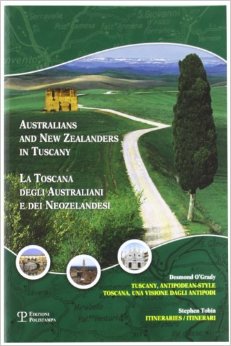Books: Tuscan ways of Antipodean escape

ROME- Australians and New Zealanders are sometimes struck by a sense of inadequacy in Europe- Compared to antecedents in Ireland, Britain and Italy, our history is short and our cultural legacy still stretching its wings. But a new book hopes to shift that perception, at least in one small but notable corner of Italy.
In 'Australians and New Zealanders in Tuscany', author and long-time expat Desmond O'Grady charts the long relationship between Tuscany and the Southern Cross, through the Antipodean expats, artists, writers and soldiers who fell for its considerable charms. For some it was a place to find love, for others a place to recover from the trauma of war.
Antipodeans often underestimate their impact on cultural heritage of Western countries. But as O'Grady explains, many Tuscans still alive today remember with gratitude the pivotal role played by Kiwi regiments in liberating their green hills and hilltop medieval towns from the Nazis in the final year of the Second World War.
Maori regiments were among the first to reach Florence, and, somewhat less gloriously according to some, it was a New Zealander, General Bernard, Cyril Freyberg who gave the order to bomb to obliteration the 6th century hilltop monastery of Monte Cassino, founded by St Benedict. It was later rebuilt stone by stone.
Much earlier, in the 19th century, many adventurous and wealthy Australians made it to Italy as part of a Grand Tour of Europe. Some, who settled here, like Daily Mail journalist and romance novelist Louise Mack, were happy to pass themselves off as British.
Others saw Italy as an alternative to Britain where they could experience European culture and history without the colonial baggage. O'Grady quotes academic Roslyn Pesman Cooper, a historian from Sydney University who worked at the State Archives in Florence for several years, who remarked: 'Italy enables Australians to claim their European heritage without the imperial midwife.'
For many Tuscany was an escape. The author paints a landscape so relaxing a young Germaine Greer laid aside her campaigns to spend her days as growing roses and home cures such as orris root, camomile and rue, which she then transformed into herbal medicines in a hilltop home laboratory.
And where acclaimed war correspondent Alan Moorehead, a great friend of Hemingway, recovered from the fray, calling Tuscany the ‘perfect balm’ to assuage six years on the battlefield.
Perhaps it should not be surprising that Australians at least feel so at home in Italy. With their vines and scorched hills, the landscapes of Tuscany bear a striking resemblance to New South Wales.
But, despite the obvious parity between the two countries, the feelings of warmth were not seemingly reciprocated by Tuscany’s greatest son, O’Grady points out.
Dante Alighieri, in his Divine Comedy, placed Purgatory in the Antipodes. Clearly he had never been there.
Hannah Roberts is the Rome Correspondent of the Daily Mail.
Australians and New Zealanders in Tuscany, By Desmond O'Grady. 216 pages. Bilingual edition. Polistampa. 16 euros.


